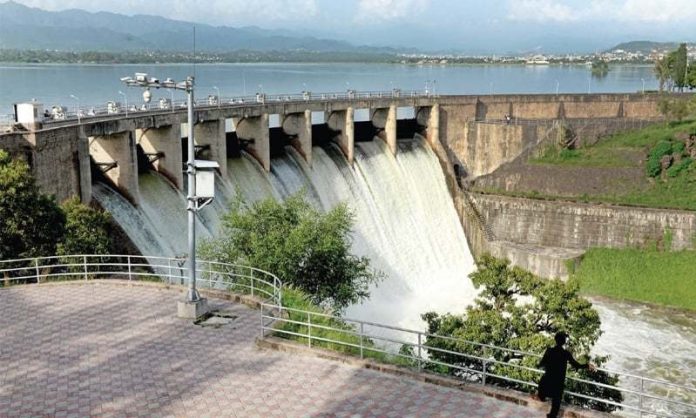PESHAWAR (APP): Citing the importance of cheap power generation for a county’s economic and social growth, developed and developing countries around the world give special impetus to hydel power generation.
With soaring prices of petroleum products, reliance on oil for power generation is being lessened around the globe, pushing countries to build more water reservoirs not only to fulfil growing energy needs but to enhance agricultural yields.
Like other SAARC countries, Pakistan is also confronted with the grave challenge of an energy crisis due to high population growth, power pilferage and non-construction of dams.
Despite 60,000MW hydel power potential, including 30,000MW mere in Khyber Pakhtunkhwa, the energy crisis has further deepened in recent years due to increase in petroleum prices, high reliance on fuel to run powerhouses, taxation, “kunda culture” and non-construction of new dams.
Prof Dr Muhammad Naeem, Economics Department of the Swabi University said hydel energy was cost-efficient for developing countries like Pakistan and underscored the need for the construction of water reservoirs and small dams for sustainable economic growth and floods mitigation in the wake of climate change challenges.
Dr Naeem said China had constructed about 98,000 dams and India 5,334 dams, while Pakistan had built only 150 dams since its independence and no big dam after Tarbela.
“The rivers in northern Khyber Pakhtunkhwa and Punjab are most suitable for construction of dams, especially small ones,” he added.
When contacted, Engr Zahoor Hussain, Director Projects, Wapda (North) said 72 percent work on multipurpose Kurram Tangi (Stage-1) Bannu and North Waziristan had been completed and expected to be inaugurated in November next year.
He said the design and feasibility study of its stage-II was under process which would be completed with a loan assistance of Asian Development Bank.
Engr Zahoor said the dam would store around 1.2 million acre feet water besides generating 80.9 MW electricity, adding over three million people of southern districts of Khyber Pakthunkhwa would be directly benefited from the dam.
Besides completion of 108MW Golen Gol dam in Chitral, the government had accelerated work on Mohmand dam of 800MW with 1.293 MAF water storage capacity that after completion would supplement/irrigate 160,000 acres of existing land and about 18,237 acres of new land with annual benefits of Rs2.23 billion, he mentioned.
Likewise, 300 million gallons water per day would also be provided to Peshawar for drinking purpose with benefits of Rs.957 million from Mohmand dam, which would also help saving Peshawar, Charsadda and Nowshera from floods.
Meanwhile, construction work on a high voltage direct current (HVDC) convertor station was in progress at Azakhel Bala Nowshera district under the CASA-1000 Project for transmission of 1300 MW inexpensive, clean, and environment-friendly electricity from Kyrgyzstan and Tajikistan via Afghanistan to Pakistan.
The CASA-1000 Project carried a great example of mutual cooperation between the governments of Pakistan, Afghanistan, Kyrgyzstan, and Tajikistan aimed at harnessing clean energy trade and building a shared regional electricity market, fighting climate change, and increasing standard of living for their populations.
According to KP Energy Department, 36.6MW Daral Khwar HPP Madain Swat was completed and electricity generation with over Rs1.3 billion annual benefits started. Likewise, 300MW Balakot HPP worth Rs 85 billion approved by ECNEC would be constructed on River Kunhar in Mansehra.
Similarly, 496MW Spat-Gah HPP amounting US$ 1,015 million is being developed for which MoU between KP government having 26pc share and M/S Korea Hydro and Nuclear Power Company (KHNP) with 74pc share was signed.
XEN Engr Ziaullah Khan of PESCO Power Distribution Company told APP that KP was currently receiving about 1873MW electricity from the national grid while its demand was about 3220 MW, facing a shortfall of 1347 that was being fulfilled through load management.
Under aggregate technical and commercial losses (ATCL) formula, the official said the areas with high ATCL losses such as Bannu, rural areas of Peshawar including Warak Road, Chagarmathi and Regi and DI Khan district were facing brunt of load shedding (16 hours), while there was no load shedding at Hayatabad and Gulbahar due to high recovery rate and lack of power pilferage.
He said Swat, Swabi, Interior Peshawar and Hazara were comparatively better in term of low line losses and high recovery.
Similarly, in merged areas, 180 MW was being drawn from the express transmission line against 1000 MW demand with 820MW shortfall due to power stealing through direct shock, a senior official of Tribal Electricity Supply Company (TESCO) told APP.
Meanwhile, the government has earmarked a sum of Rs 107413.044 million for various ongoing and new schemes of the power sector in the Public Sector Development Programme (PSDP) for the financial year 2023-24.
According to the budgetary document, out of the total allocation, the government allocated Rs 81,774.431 million from the local component while Rs 25,638.613 million from the foreign aid component.
Under ongoing schemes in KP, Rs 1600 million each were earmarked for 220kV Hairpur Substation and 220kV Swabi Substation, Rs 1,059 million for replacement of LT Bare conductor with ABC Cable in Peshawar Khyber Circle and Bannu Circle, and Rs 964 million for electrification works at different valleys of District Chitral in the PSDP for FY 2023-24.
Similarly, a sum of Rs 13,800 million had been specified for evacuation of power from Suki Kinari, Kohala, Mahal HPPs, Rs 5,667.094 million for evacuation of power from 2160 MW Dasu stage-1, and Rs 16,099.255 million for 500 kV HVDC Transmission System between Tajikistan and Pakistan (CASA-1000).
Additionally, eight projects for supplying electricity to Special Economic Zones (SEZs) have been allocated a total of Rs. 7,267.352 million and by the end of June 2024, the transmission sector is expected to have an additional capacity of 3,750 MVA on the 500kV grid and 6,900 MVA on the 220kV grid. The transmission lines will be extended by 522 km on the 500kV level and 668 km on the 220kV level.
Resultantly, 6,985 villages would be electrified and 1,403,592 consumers for Distribution Companies (DISCOs) would be facilitated besides extending distribution lines of 132 kV by 1,843 km, and the capacity of 132 kV grids would be strengthened by 4,199 MVA.
Despite all these steps, there was still a need to work on more hydel power plants and establish large reservoirs for growing energy needs and trends of urbanization if Pakistan wanted to strengthened its economy and step into the developed world.







